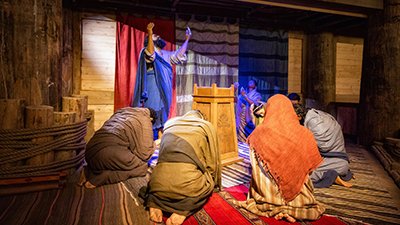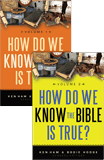
Was Jairus’ Daughter Dead or Near Death When He Came to See Jesus?
God’s Word is perfect and cannot contradict itself; therefore, whenever we see two or more passages of Scripture that appear to contradict each other, we need to study the passages in more detail. We must make sure we are examining the same event, do not take words out of context, recognize any figures of speech or poetic language being used, and be aware of any translational issues of words or phrases, from the Hebrew, Aramaic, or Greek into English.
Let’s compare the three accounts of the healing of Jairus’ daughter in each Gospel.
While He spoke these things to them, behold, a ruler came and worshiped Him, saying, "My daughter has just died, but come and lay Your hand on her and she will live." (Matthew 9:18)
And behold, one of the rulers of the synagogue came, Jairus by name. And when he saw Him, he fell at His feet and begged Him earnestly, saying, "My little daughter lies at the point of death. Come and lay Your hands on her, that she may be healed, and she will live." (Mark 5:22–23)
And behold, there came a man named Jairus, and he was a ruler of the synagogue. And he fell down at Jesus’ feet and begged Him to come to his house, for he had an only daughter about twelve years of age, and she was dying. But as He went, the multitudes thronged Him. (Luke 8:41–42)
The apparent contradiction then is whether Jairus’ daughter was dead, or near death. It is apparent from the context of each passage that they tell of the same event. There is no overt poetic language or indication of parable here. This is a historical narrative passage in all three accounts, with varying degrees of detail supplied in each. Yet there may be a translational issue at the heart of this apparent contradiction.
Let’s examine the most likely solutions to this dilemma that have been supplied by Bible commentators over the years.
Solution 1: Matthew Didn’t Record the First Statement of Jairus
Matthew may have simply omitted the initial statement of Jairus and instead focused on the second one, which he alone recorded, although it is inferred from Luke 8:50. This theory has merit because Matthew is the only one to also omit that some people came from Jairus’ house and told him that his daughter had just died (Mark 5:35–36; Luke 8:49–50). So chronologically, Jairus told Jesus his daughter was near death (and this was recorded in Mark and Luke), and then when he got word his daughter was dead, he told Jesus the second time and used the phrase that is recorded in Matthew. Luke 8:50 corroborates this by stating that Jesus answered (replied back to) Jairus after he had learned of Jairus’ daughter’s death. It also is worth noting that in Mark and Luke the man begged Jesus to come while his daughter still lived, but in the Matthew account he was “worshipping” Jesus and believed that Jesus could resurrect his daughter. This would further confirm that Matthew omitted or condensed the first discourse with Jairus and focused on the second one after Jairus had been told of his daughter’s death.
Solution 2: Different Point of Emphasis
The translation of the phrase “just died” in Matthew could also be translated “near death.” Arti eteleutēsen is the Greek phrase used in this text, and the Greek word arti is often translated as “henceforth” or “hereafter.” If this theory is correct, then Matthew did not omit any discourse with Jairus; there was just a different point of emphasis. According to commentator Craig Blomberg,
As consistently throughout his Gospel (and esp. with miracle stories), Matthew abbreviates Mark, this time to such an extent that he seems to contradict the parallel accounts (Mark 5:21–43; Luke 8:40–56). Instead of coming to plead with Jesus while his daughter is still alive, Jairus apparently arrives only after her death. Yet to call this a contradiction is anachronistically to impose on an ancient text modern standards of precision in story telling. What is more, in a world without modern medical monitors to establish the precise moment of expiry, there is not nearly so much difference between Matthew’s arti eteleutēsen in v. 18 (which could fairly be translated “just came to the point of death”; cf. Heb 11:22) and eschatos echei in Mark 5:23 (which could also be rendered “is dying”). What is important is not the precise moment of death but Jairus’s astonishing faith.1
Proposed Sequence of Events
Here is how things may have taken place. When Jairus left his house, his daughter was at the point of death; so he may have thought that by the time he was with Jesus, she quite possibly had already died. Indeed, by the time he arrived, she had passed away, as confirmed by the messenger who brought the account of her death before Jesus came to the house.
That Jairus should appeal to Christ on this occasion is very remarkable considering that Jewish leaders were often the people most averse to Jesus. It is also striking that he should fall down and worship Jesus, if not as God, since as yet he might be ignorant of Christ’s deity, yet he behaved with profound respect toward Him, as to a great teacher, known healer, and prophet. That very act of Jairus coming to Jesus when his child was past all hope of recovery, when he had reason to believe she was actually dead, as she indeed now was, affirms that he really believed that if Christ would come to his house and lay his hand upon his daughter, she would certainly be restored to life again.
Perhaps Jairus, being intimately familiar with the Torah, had in mind Elijah and Elisha, whom God had given the power of being able to resurrect the dead (1 Kings 17:17–24; 2 Kings 4:18–37), in both instances using physical contact with the recently deceased. Perhaps he had heard of Christ’s healing powers and dared hope they would be sufficient to the task. Luke 8:43–48 records that while Jairus was walking with Him, Jesus healed a woman with a blood issue. Jairus therefore was an eyewitness to the power of Christ even before they reached his house.
No Contradiction, But Different Focal Points
In any event, the passages do not contradict each other, but just show the different focus each Gospel writer emphasized. Whether it was through just recording part of the event, or perhaps the phrases “even now dead” or “just died” meaning “imminently near death,” all three Gospel accounts bring out a slightly different emphasis. Their main point is unmistakable: Jesus had power to raise the dead as authentication of His deity.
Footnotes
- Craig Blomberg, Matthew, vol. 22, The New American Commentary (Nashville: Broadman & Holman Publishers, 1992), 160.
Recommended Resources

Answers in Genesis is an apologetics ministry, dedicated to helping Christians defend their faith and proclaim the good news of Jesus Christ.
- Customer Service 800.778.3390
- © 2024 Answers in Genesis






